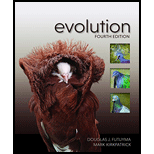
Concept explainers
(a)
To explain: The reason for fusion of hind limb bones during embryonic development of birds is a derived trait, not an ancestral trait, relative to the unfused condition in crocodiles.
Introduction: Inheritance is the basis of evolution. The study of the evolution of descendants from common ancestors is called phylogeny. A phylogenetic tree is a diagrammatical analysis of the evolution of an organism.
(b)
To explain: The reasons for unstable phylogenetic evidence of the development of pentadactyly are homologous in humans and crocodiles.
Introduction: The study of the evolution of descendants from common ancestors is called phylogeny. Depending upon common antecedents, there are three taxa, namely monophyletic (contains all descents from a common ancestor), paraphyletic (comprises only some descendants of a common ancestor), and polyphyletic (contains species with different ancestors).
(c)
To explain: The reasons for unstable phylogenetic evidence of the development of sting of wasp from ovipositor.
Introduction: Inheritance is the basis of evolution. The study of the evolution of descendants from common ancestors is called phylogeny. Depending upon common antecedents, there are three taxa, namely monophyletic (contains all descents from a common ancestor), paraphyletic (comprises only some descendants of a common ancestor), and polyphyletic (contains species with different ancestors).
(d)
To explain: The reasons for unstable phylogenetic evidence of wings and wingless insects.
Introduction: Inheritance is the basis of evolution. The study of the evolution of descendants from common ancestors is called phylogeny. A phylogenetic tree is a diagrammatical analysis of the evolution of an organism.
(e)
To explain: The reasons for unstable phylogenetic evidence of some traits in frogs that are very similar to those of their deep ancestors but others that are relatively advanced.
Introduction: Inheritance is the basis of evolution. The study of the evolution of descendants from common ancestors is known as phylogeny. A phylogenetic tree is a diagrammatical analysis of the evolution of an organism.
Want to see the full answer?
Check out a sample textbook solution
Chapter 2 Solutions
Evolution, Fourth Edition (looseleaf)
- Which of the following is not a sequence-specific DNA binding protein? 1. the catabolite-activated protein 2. the trp repressor protein 3. the flowering locus C protein 4. the flowering locus D protein 5. GAL4 6. all of the above are sequence-specific DNA binding proteinsarrow_forwardWhich of the following is not a DNA binding protein? 1. the lac repressor protein 2. the catabolite activated protein 3. the trp repressor protein 4. the flowering locus C protein 5. the flowering locus D protein 6. GAL4 7. all of the above are DNA binding proteinsarrow_forwardWhat symbolic and cultural behaviors are evident in the archaeological record and associated with Neandertals and anatomically modern humans in Europe beginning around 35,000 yBP (during the Upper Paleolithic)?arrow_forward
- Describe three cranial and postcranial features of Neanderthals skeletons that are likely adaptation to the cold climates of Upper Pleistocene Europe and explain how they are adaptations to a cold climate.arrow_forwardBiology Questionarrow_forward✓ Details Draw a protein that is embedded in a membrane (a transmembrane protein), label the lipid bilayer and the protein. Identify the areas of the lipid bilayer that are hydrophobic and hydrophilic. Draw a membrane with two transporters: a proton pump transporter that uses ATP to generate a proton gradient, and a second transporter that moves glucose by secondary active transport (cartoon-like is ok). It will be important to show protons moving in the correct direction, and that the transporter that is powered by secondary active transport is logically related to the proton pump.arrow_forward
- drawing chemical structure of ATP. please draw in and label whats asked. Thank you.arrow_forwardOutline the negative feedback loop that allows us to maintain a healthy water concentration in our blood. You may use diagram if you wisharrow_forwardGive examples of fat soluble and non-fat soluble hormonesarrow_forward
- Just click view full document and register so you can see the whole document. how do i access this. following from the previous question; https://www.bartleby.com/questions-and-answers/hi-hi-with-this-unit-assessment-psy4406-tp4-report-assessment-material-case-stydu-ms-alecia-moore.-o/5e09906a-5101-4297-a8f7-49449b0bb5a7. on Google this image comes up and i have signed/ payed for the service and unable to access the full document. are you able to copy and past to this response. please see the screenshot from google page. unfortunality its not allowing me attch the image can you please show me the mathmetic calculation/ workout for the reult sectionarrow_forwardIn tabular form, differentiate between reversible and irreversible cell injury.arrow_forwardhelparrow_forward
 Biology: The Dynamic Science (MindTap Course List)BiologyISBN:9781305389892Author:Peter J. Russell, Paul E. Hertz, Beverly McMillanPublisher:Cengage Learning
Biology: The Dynamic Science (MindTap Course List)BiologyISBN:9781305389892Author:Peter J. Russell, Paul E. Hertz, Beverly McMillanPublisher:Cengage Learning Biology (MindTap Course List)BiologyISBN:9781337392938Author:Eldra Solomon, Charles Martin, Diana W. Martin, Linda R. BergPublisher:Cengage Learning
Biology (MindTap Course List)BiologyISBN:9781337392938Author:Eldra Solomon, Charles Martin, Diana W. Martin, Linda R. BergPublisher:Cengage Learning Human Heredity: Principles and Issues (MindTap Co...BiologyISBN:9781305251052Author:Michael CummingsPublisher:Cengage Learning
Human Heredity: Principles and Issues (MindTap Co...BiologyISBN:9781305251052Author:Michael CummingsPublisher:Cengage Learning Human Biology (MindTap Course List)BiologyISBN:9781305112100Author:Cecie Starr, Beverly McMillanPublisher:Cengage Learning
Human Biology (MindTap Course List)BiologyISBN:9781305112100Author:Cecie Starr, Beverly McMillanPublisher:Cengage Learning Biology 2eBiologyISBN:9781947172517Author:Matthew Douglas, Jung Choi, Mary Ann ClarkPublisher:OpenStax
Biology 2eBiologyISBN:9781947172517Author:Matthew Douglas, Jung Choi, Mary Ann ClarkPublisher:OpenStax Concepts of BiologyBiologyISBN:9781938168116Author:Samantha Fowler, Rebecca Roush, James WisePublisher:OpenStax College
Concepts of BiologyBiologyISBN:9781938168116Author:Samantha Fowler, Rebecca Roush, James WisePublisher:OpenStax College





